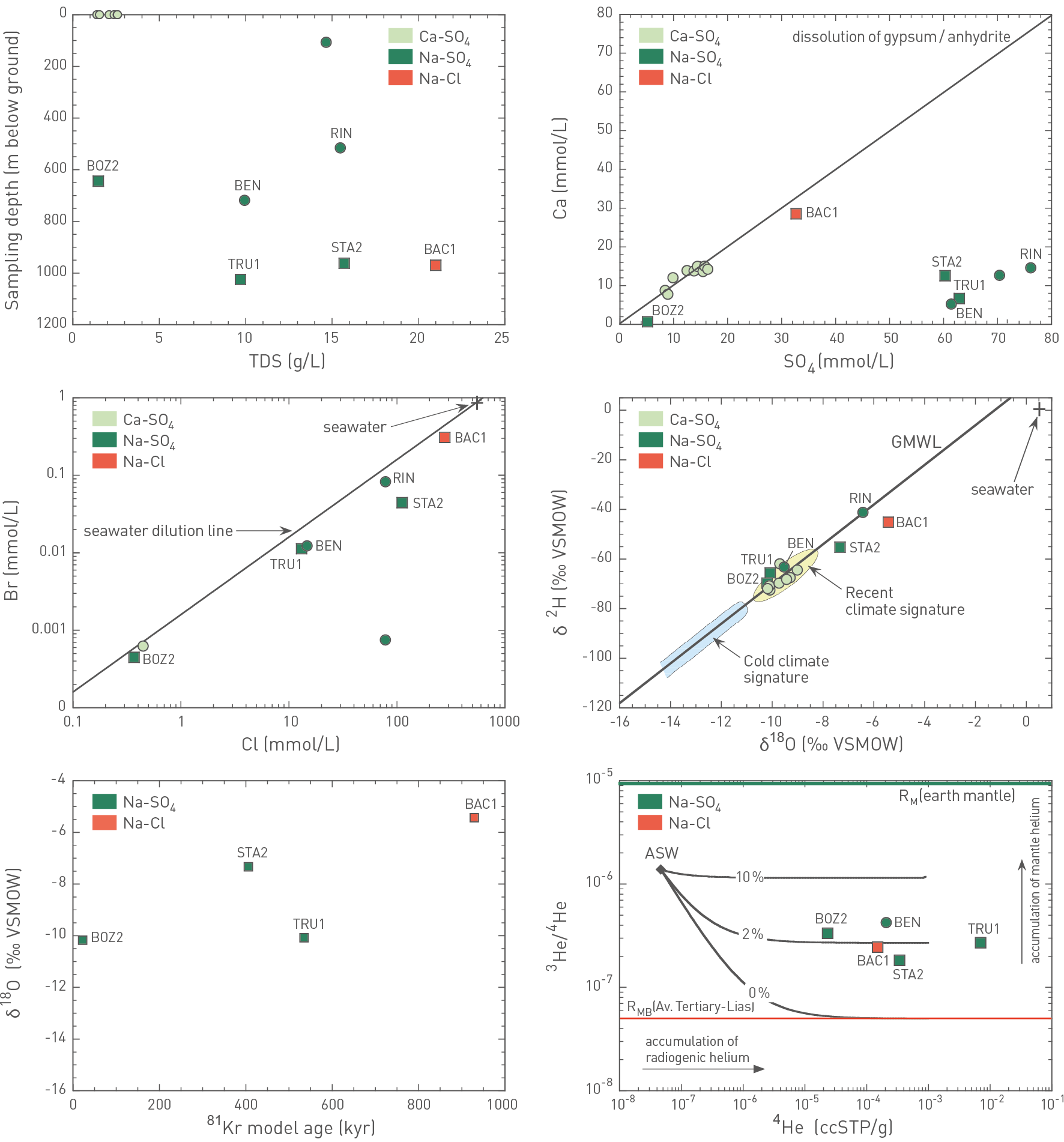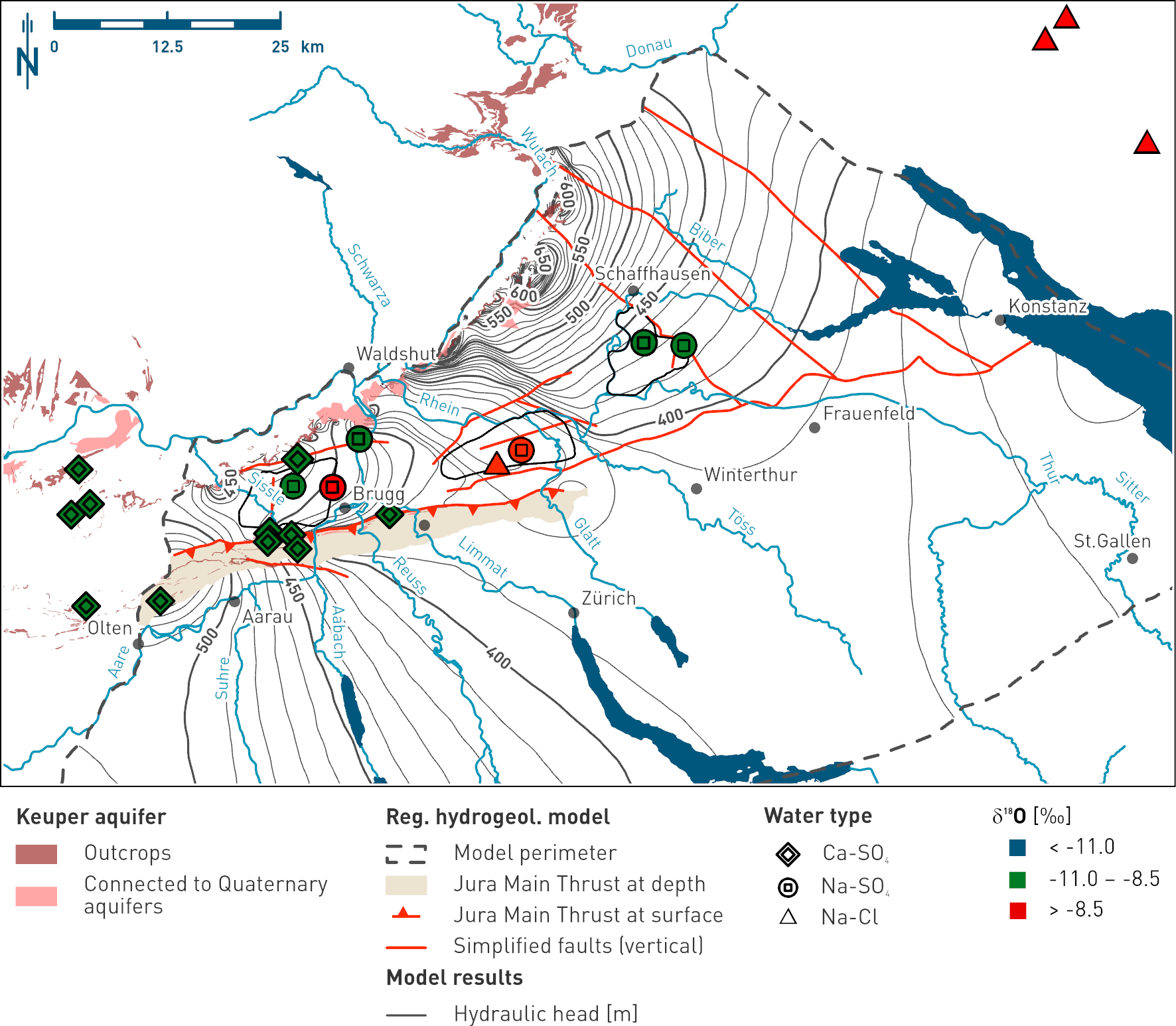A) Hydrogeochemical characterisation and groundwater origin
Groundwater samples from the Keuper aquifer in Northern Switzerland display a marked variation in their composition, with TDS concentrations ranging from about 2 to more than 20 g/L (Fig. 4‑110). Shallow groundwaters mainly occurring west of the Aare River in the Jura Mountains (Fig. 4‑111) are of the Ca-SO4 type and show TDS values below 3 g/L. Groundwaters from depths below 100 m mostly refer to the Na-SO4 type and display TDS concentrations up to 16 g/L. The only exception is the Keuper groundwater retrieved from the BAC1 borehole, which refers to the Na-Cl type with a TDS concentration of 21 g/L.
The Ca-SO4 type groundwaters as well as the Na-Cl groundwater from BAC1 plot close to or on the 1:1 correlation between the concentrations of Ca2+ and SO42- (Fig. 4‑110). This demonstrates that Ca and SO4 in these groundwaters are mainly inherited from the dissolution of gypsum or anhydrite. In addition, these waters may show significant Mg concentrations indicating a dedolomitisation reaction where gypsum/anhydrite and dolomite dissolve and calcite precipitates. Consequently, depending on the residence time the groundwaters are at or close to saturation with calcite, dolomite and gypsum or anhydrite.
In contrast, the Na-SO4 type groundwaters strongly deviate from the 1:1 correlation between Ca2+ and SO42-. These groundwaters are controlled by processes in addition to the dissolution of anhydrite. The most likely candidate is the diffusive exchange with porewater of the above-lying aquitards coupled with cation exchange reactions in these clay-mineral-rich units. The porewaters show higher concentrations of Na and Cl than the Keuper groundwaters, causing a diffusive flux towards the aquifer (Wersin et al. 2023).
The ratios of stable isotopes of water of shallow Ca-SO4 type groundwaters fall within the range of meteoric water infiltrating under similar climatic conditions to today. Together with significant 3H activities of selected samples and the occurrence of Keuper outcrops in the Jura Mountains (Fig. 4‑111), this indicates short residence times of a few years to a few decades. In contrast, about half of the deeper Na-SO4 groundwaters as well as the Na-Cl type groundwater from BAC1 display signatures of stable isotopes inconsistent with recharge under current climatic conditions. The sample from RIN plots on the GMWL at higher δ18O and δ2H values than currently observed, indicating that recharge occurred during warmer climatic conditions. The samples from STA2 and BAC1 plot slightly below the GMWL (Fig. 4‑110), which is probably caused by the diffusive exchange with porewater in the above-lying aquitards as described above. Based on the Br/Cl ratio, this porewater is likely of marine origin (Section 4.6.3).
With the exception of the Keuper sample from BOZ2, Na-SO4 and Na-Cl type groundwaters show 81Kr model ages ranging from 400 to 929 kyr. Inferred residence times in the order of several 100 kyr for these groundwaters compare well with their elevated 4He concentrations and 3He/4He ratios (Fig. 4‑110). Interestingly, the sample from BOZ2 shows a much lower 81Kr model age of < 22 kyr, which is consistent with the 14C model age of 10 – 14 kyr.

Fig. 4‑110:Cross-plots illustrating the behaviour of key hydrogeochemical parameters in groundwaters collected from the Keuper aquifer in Northern Switzerland
Circle and square symbols represent samples reported in Waber & Traber (2022) and collected during the TBO campaign, respectively. Sampling locations are only provided for the samples collected in the three siting regions. Samples from hydrocarbon exploration wells in the central Molasse Basin have limited datasets and are not shown. RMB: average 3He/4He production ratio of Molasse to Lias Group sediments in the Swiss Molasse Basin. ASW: air-saturated water (Kipfer et al. 2002). Black lines in the He-plot indicate the behaviour of hypothetical mixtures between ASW and RMB as well as different proportions of mantle helium (RM). The Br/Cl ratio of the groundwater from TRU1 is affected by a high uncertainty of the Br analysis.

Fig. 4‑111:Map showing the spatial distribution of δ18O values in groundwaters collected from the Keuper aquifer as indication of the recharge conditions of the different water types
The symbols represent the water types while the colour of the fillings indicates the δ18O value range of the samples (see legend). The data range of δ18O of -11.0 to -8.5 ‰ VSMOW is representative for recent groundwaters of the region. Green colour denotes groundwater formed during climatic conditions similar as today in the study area. The map also shows the Keuper aquifer outcrops, a simplified regional fault pattern, and the hydraulic head isolines according to the regional hydrogeological model (base case model, Section 4.5.4.4).
B) Regional groundwater evolution
The different hydrogeochemical signatures of the Keuper groundwaters in Northern Switzerland reflect different stages in their hydrogeochemical evolution. This is discussed below for four major groups of water types representing shallow groundwater close to outcrops as well as deep groundwater in the three siting regions.
Ca-SO4 type groundwaters: Shallow groundwater close to outcrops
These groundwaters are controlled by the dissolution of gypsum and/or anhydrite present in the Bänkerjoch Formation (Section 4.5.3.11) or in the Klettgau Formation. Accordingly, the Ca-SO4 type groundwaters represent the first stage of the hydrogeochemical evolution when meteoric water infiltrates into the Keuper aquifer. This is consistent with short residence times inferred from the detection of 3H and stable isotope signatures overlapping with recharge signatures observed today.
Na-SO4 type groundwaters without stable isotope shift: Deep groundwater in the ZNO siting region
In the ZNO siting region, groundwater samples from the Keuper aquifer were retrieved from the TRU1 and BEN boreholes. Both samples are of Na-SO4 type and show a stable isotope signature consistent with recharge under similar climatic conditions to today (Fig. 4‑110). Moreover, the chemical composition of the two samples is very similar. In addition to the dissolution of anhydrite, these groundwaters are controlled by the diffusive uptake of Na and Cl from the porewater of the above-lying aquitards. The strong hydrogeochemical similarity of the two samples suggests that, in the ZNO siting region, the Keuper operates as a well-connected aquifer. This is consistent with the observation that, in this region, the Seebi Member regionally occurs as dolomitic breccia with frequent macropores, probably causing the high transmissivities observed in the Klettgau Formation of the BEN and TRU1 boreholes (Sections 4.5.3 and 4.2). Additional evidence for a regionally well-connected Keuper aquifer is provided by the tracer profiles along the MAR1, TRU1 and BEN drill cores, all showing strong concentration gradients between the Keuper aquifer and porewater of the above-lying aquitards (Section 4.6), typical for a single hydraulic activation of the aquifer. Despite these observations, the flow velocities appear to be very slow based on the relatively high 81Kr model age of the TRU1 groundwater (535 kyr; Fig. 4‑110), which is consistent with the corresponding porewater tracer simulations suggesting an activation of the aquifer some 650 kyr ago (Section 4.6.2).
Na-SO4 and Na-Cl type groundwater with stable isotope shift: Deep groundwaters in the NL siting region
In the NL siting region, groundwater samples from the Keuper aquifer were retrieved from the boreholes STA2 and BAC1. While the sample from STA2 is of Na-SO4 type, the one from BAC1 relates to Na-Cl type. In contrast to the two samples from the ZNO siting region, their stable isotope composition is shifted to the right of the GMWL, suggesting diffusive uptake of 2H and 18O with a marine signature from the porewater of the above-lying aquitards, in addition to the uptake of Na and Cl. Accordingly, the Keuper groundwaters in the NL region represent a hydrogeochemically more evolved state than those from the ZNO siting region. This is probably caused by the fact that Keuper groundwater samples in NL were retrieved from individual sandstone channels of the Ergolz Member (Sections 4.5.3.10), which probably does not represent a well-connected regional aquifer. Consequently, the tracer profiles of the STA2 and particularly BAC1 boreholes show lower concentration gradients between the Keuper groundwater and porewater of the above-lying aquitards than the corresponding profiles in the ZNO siting region (Section 4.6). Despite the different hydrogeochemical signature, the 81Kr model ages of Keuper groundwaters from the ZNO and NL siting regions are in the same order of magnitude (406 – 929 kyr; Fig. 4‑110). This may result from a younger, 81Kr-bearing water component of similar mean residence time in both siting regions but different mixing proportions with an older, 81Kr-free and more saline component (higher contribution of the more saline component in NL than in ZNO).
Na-SO4 type groundwaters without stable isotope shift but strongly contrasting signature: Deep groundwater in the JO siting region
In the JO siting region, groundwater samples from the Keuper aquifer could be retrieved from the RIN and BOZ2 boreholes. Both samples are of the Na-SO4 type, display similar Ca/SO4 and Br/Cl ratios close to the anhydrite dissolution and seawater dilution trends, respectively, and their stable isotope signatures fall on the Global Meteoric Water Line GMWL (Fig. 4‑110). Besides these similarities, there are notable differences despite the two boreholes being located only about 5 km apart. The most prominent ones include a much higher TDS concentration of the RIN sample and a corresponding stable isotope signature, which is inconsistent with the infiltration of meteoric water under current climatic conditions. Based on the chemical similarity but much lower salinity (RIN: 15 g/L; BOZ2: 1.5 g/L), the groundwater from BOZ2 can be interpreted as a strongly diluted version of the RIN sample. Consequently, the Keuper aquifer at BOZ2 is probably much more active hydraulically than at RIN. This is consistent with 14C and 81Kr model ages of < 14 kyr and < 22 kyr, respectively, as well as the signature of stable isotopes, suggesting that the diluting water component infiltrated in the current Holocene interglacial period. The large presence of a young groundwater component at BOZ2 also agrees well with high tracer concentration gradients between the Keuper groundwater and porewater of the above-lying aquitards in the corresponding tracer profiles (Section 4.6) and may relate to groundwater from the outcrops to the north of BOZ2. It follows that there are almost stagnant conditions at RIN, while at BOZ2 the Keuper aquifer appears to be much more active hydraulically.
Summary of the Keuper aquifer in the siting regions
The Keuper aquifer represents spatially limited and partly isolated local aquifers with often quasi-stagnant conditions, as manifested by the fact that, in the three siting regions, Keuper groundwater could only be retrieved from about half of the deep boreholes. The isolated and local nature is linked to the local lithofacies (Section 4.5.3.10) of the potential transmissive layers.
In the JO siting region, the hydrogeochemical data evidence large differences in flow dynamics between BOZ2 and RIN. The characteristics of the RIN sample point to high residence times. The BOZ2 sample is more dilute and has a 81Kr model age < 22 kyr. Overall, these characteristics agree with the general NW-SE flow direction suggested by the hydrodynamic model (Fig. 4‑111).
In the NL siting region, groundwater could only be sampled in 2 out of 5 boreholes. Both samples are characterised by high 81Kr model ages (STA2 406 and BAC1 929 kyr) but distinct chemical differences. Their stable isotope composition is shifted to the right of the GMWL, suggesting diffusive uptake from the porewater of the above-lying aquitards. This exchange is particularly evolved in the case of BAC1. Overall, these are hydrogeochemically highly evolved groundwaters pointing to quasi-stagnant conditions.
In the ZNO siting region, the groundwater samples from BEN and TRU1 have similar hydrochemical composition and plot on the Global Meteoric Water Line in the range of recent groundwaters. The similarity is in agreement with a well-connected aquifer in this siting region. However, the 81Kr model age of the TRU1 groundwater (535 kyr) point to very low flow velocities.

